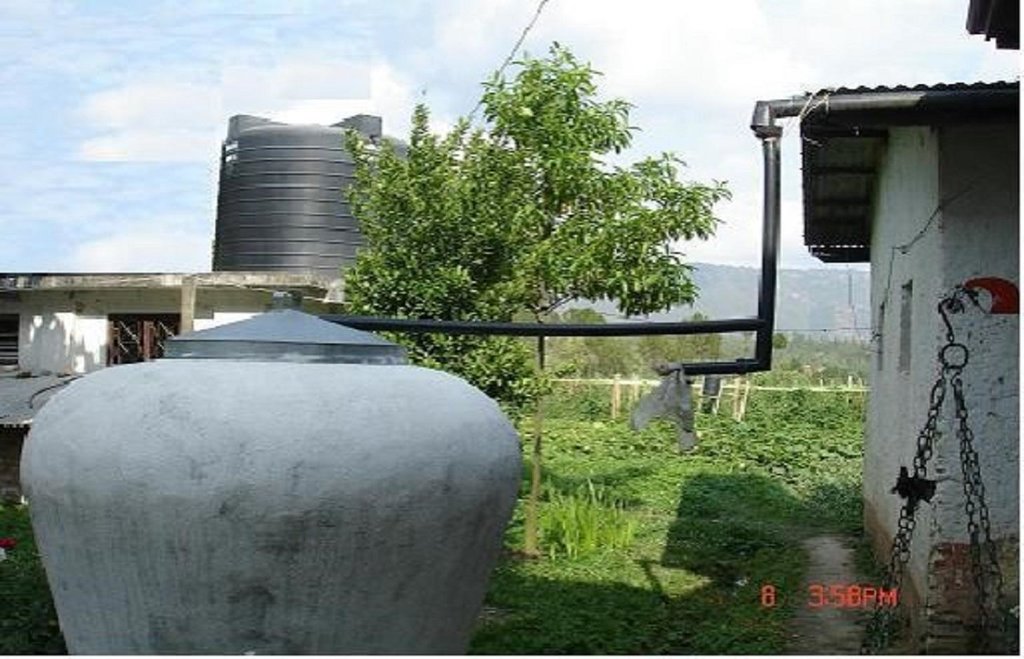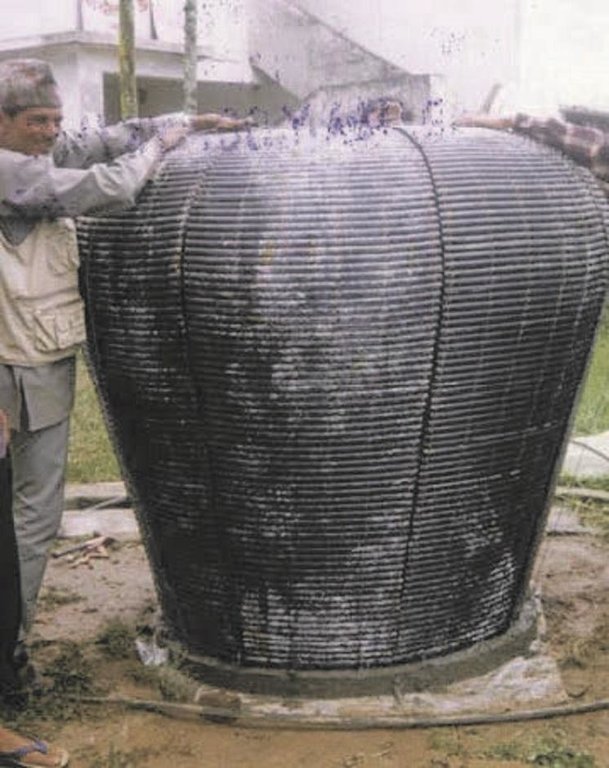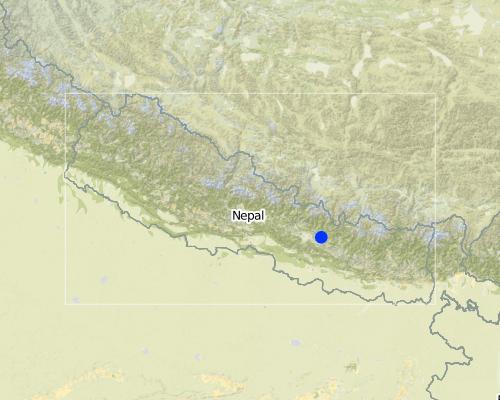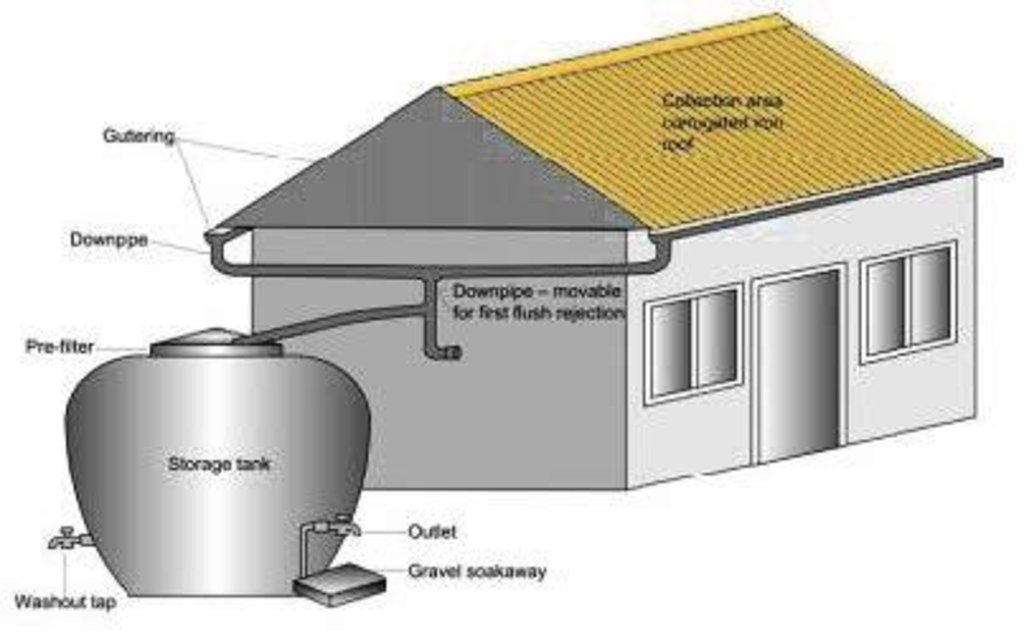Rooftop rainwater harvesting system [Nepal]
- Criação:
- Atualização:
- Compilador/a: Madhav Dhakal
- Editor: –
- Revisor: David Streiff
Akase paani sankalan pranali - Nepali
technologies_1497 - Nepal
Veja as seções
Expandir tudo Recolher tudo1. Informação geral
1.2 Detalhes do contato das pessoas capacitadas e instituições envolvidas na avaliação e documentação da tecnologia
Especialista em GST:
Especialista em GST:
Nome da(s) instituição(ões) que facilitou(ram) a documentação/ avaliação da Tecnologia (se relevante)
ICIMOD International Centre for Integrated Mountain Development (ICIMOD) - Nepal1.3 Condições em relação ao uso da informação documentada através de WOCAT
Quando os dados foram compilados (no campo)?
20/10/2006
O/a compilador/a e a(s) pessoa(s) capacitada(s) aceitam as condições relativas ao uso de dados documentados através da WOCAT:
Sim
2. Descrição da tecnologia de GST
2.1 Descrição curta da tecnologia
Definição da tecnologia:
A water harvesting system in which rain falling on a roof is led through connecting pipes into a ferro-cement water collecting jar.
2.2 Descrição detalhada da tecnologia
Descrição:
Many households in Nepal’s midhills suffer from water shortages during the pronounced dry season. The technology described here - harvesting roofwater during times of heavy rainfall for later use - is a promising way of improving people’s access to water for household use, especially for households with no or only limited access to spring or stream water. The technology has yet to be extensively adopted in Nepal’s midhills.
Purpose of the Technology: The technology was introduced in the Jhikhu Khola watershed to demonstrate an alternative source of water for domestic use (mainly drinking water). This technology is appropriate for scattered rural households in mountaineous areas. The harvesting system consists of a catchment roof, conveyance pipes, and a storage jar. The pipes include a gutter system made from longitudinally split polythene pipe which has a flushing system that allows the system to be periodically flushed clean.
The collected water enters a 500 or 2000 litre capacity ferro-cement jar made using a mould (see photo). A preconstructed mould made from iron rods and polythene pipes is installed on a concrete base plate. Metal wires are extended from the base plate over the main mould to the top. Chicken mesh is then wrapped over the mould and tied securely with thin wire. A cement coating is applied over the metal structure. The jar is finished with three coatings of cement and the opening is covered with a fine nylon mesh to filter out undesired coarse matter. A tin lid is placed over the top.
Establishment / maintenance activities and inputs: A tap is fixed about 20 cm above the ground. This height allows for water to be collected in the typical 15 litre local water vessels (gagri) and avoids collection of too much water in bigger vessels as well as minimising the dead storage of water (Nakarmi et al. 2003). Trained masons can easily install the entire system. Provided all the materials and the mould are available, the entire system can be put together in about a week. The main maintenance task is to keep the roof clean, especially after long dry periods. This is done using the gutter pipe flushing system in which the first dirty water from the roof is diverted away from the jar.
2.3 Fotos da tecnologia
2.5 País/região/locais onde a tecnologia foi aplicada e que estão cobertos nesta avaliação
País:
Nepal
Região/Estado/Província:
Kharelthok, Sathighar, Panchkhal, Hokse and Patalekhet VDCs of the Jhikhu Khola watershed
Especificação adicional de localização:
Kavrepalanchowk district
Map
×2.6 Data da implementação
Caso o ano exato seja desconhecido, indique a data aproximada:
- menos de 10 anos atrás (recentemente)
2.7 Introdução da tecnologia
Especifique como a tecnologia foi introduzida:
- através de projetos/intervenções externas
Comentários (tipos de projeto, etc.):
Water harvesting is an ancient practice, the system used in the Jhikhu Khola watershed came from Thailand, so the technology is often called 'Thai jar". In Nepal, the Rural Water Supply and Sanitation Support Programme (RWSSSP), which is jointly funded by the Government of Finland and His Majesties Government of Nepal, introduced it in the water deficit districts of western Nepal (Arghakhanchi, Gulmi, Kapilvastu, Nawalparasi, Palpa, Parbat, and Rupandehi).
3. Classificação da tecnologia de GST
3.1 Principal/principais finalidade(s) da tecnologia
- Access to water
3.2 Tipo(s) atualizado(s) de uso da terra onde a tecnologia foi aplicada

Assentamentos, infraestrutura
- Assentamentos, edificações
Observações:
courtyard
Comentários:
Major land use problems (compiler’s opinion): Inadequate water supply during the late winter and pre-monsoon months and sediment contamination during the wet season. The discharge from traditional water sources like dug-out ponds, springs, seepage ‘holes’, shallow wells and streamlets becomes limited soon after the end of the monsoon.
Major land use problems (land users’ perception): Many settlements are located on ridge tops and most water sources are located below making it difficult to provide water to households through networks of pipes. Women and girls often face hardship in carrying the water uphill, especially during the monsoon when trails are slippery.
Constraints of settlement / urban
3.3 Mais informações sobre o uso da terra
Número de estações de cultivo por ano:
- 3
Especifique:
Longest growing period in days: 150; Longest growing period from month to month: Jun - Oct; Second longest growing period in days: 120; Second longest growing period from month to month: Nov - Feb
3.4 Grupo de GST ao qual pertence a tecnologia
- Coleta de água
3.5 Difusão da tecnologia
Especifique a difusão da tecnologia:
- Aplicado em pontos específicos/concentrado numa pequena área
Comentários:
Roof rainwater harvesting jars were demonstrated mostly in the villages located at the watershed divides, hilltops, and elevated terraces where communities face chronic water shortage particularly during the dry period.
3.6 Medidas de GST contendo a tecnologia

Medidas estruturais
- S5: Represa, bacia, lago
3.7 Principais tipos de degradação da terra abordados pela tecnologia

Deteriorização física do solo
- Pw: estagnação hídrica
Comentários:
Main causes of degradation: change of seasonal rainfall
3.8 Redução, prevenção ou recuperação da degradação do solo
Especifique o objetivo da tecnologia em relação a degradação da terra:
- Reduzir a degradação do solo
4. Especificações técnicas, implementação de atividades, entradas e custos
4.1 Desenho técnico da tecnologia
4.2 Especificações técnicas/ explicações do desenho técnico
A water harvesting system with roof catchment, connecting pipes and storage tank.
Technical knowledge required for field staff / advisors: high
Technical knowledge required for land users: high
Main technical functions: water harvesting / increase water supply
Structural measure: Dam/ pan/ pond
Material: Concrete
Structural measure: Jar
Structural measure: Gutter
Structural measure: pipes
Construction material (other): Cement
4.3 Informação geral em relação ao cálculo de entradas e custos
Especifique como custos e entradas foram calculados:
- Por unidade de tecnologia
Especifique a unidade:
Rooftop rainwater harvesting system
Especifique a moeda utilizada para os cálculos de custo:
- Dólares norte-americanos
Indique a média salarial da mão-de-obra contratada por dia:
2.10
4.4 Atividades de implantação
| Atividade | Tipo de medida | Periodicidade | |
|---|---|---|---|
| 1. | Construct the concrete base plate with the help of base moluld | Estrutural | 1st day of a week |
| 2. | Curing work | Estrutural | 2nd to 7th days of a week |
| 3. | Final checking and metal cap putting over the top of the jar | Estrutural | 7th day of a week |
| 4. | First coat of cement | Estrutural | 2nd day of a week |
| 5. | Gutter and pipe fitting; including flush pipe | Estrutural | 4th day of a week |
| 6. | Inner coat of cement | Estrutural | 6th day of a week |
| 7. | Main mould installation with the help of metal wires, wrapping of chicken mesh | Estrutural | 2nd day of a week |
| 8. | Removal of mould | Estrutural | 6th day of a week |
| 9. | Second coat of cement | Estrutural | 3rd day of a week |
4.5 Custos e entradas necessárias para a implantação
| Especifique a entrada | Unidade | Quantidade | Custos por unidade | Custos totais por entrada | % dos custos arcados pelos usuários da terra | |
|---|---|---|---|---|---|---|
| Mão-de-obra | Construction of rooftop rainwater harvesting system | Persons/unit | 19,5 | 2,1 | 40,95 | 25,0 |
| Material de construção | Cement | unit | 1,0 | 23,6 | 23,6 | |
| Material de construção | Sand and aggregate | unit | 1,0 | 1,4 | 1,4 | 100,0 |
| Material de construção | Chicken wire mesh | unit | 1,0 | 20,9 | 20,9 | |
| Material de construção | Metal jar cover | unit | 1,0 | 5,5 | 5,5 | |
| Material de construção | Plastic sheet/mosquito screen | unit | 1,0 | 1,5 | 1,5 | |
| Material de construção | Polyethylene, pipes, reducer | unit | 1,0 | 23,7 | 23,7 | |
| Material de construção | Nail, clamps, pipe elbow etc. | unit | 1,0 | 3,6 | 3,6 | |
| Material de construção | Brass tap. socket, seal tap | unit | 1,0 | 3,5 | 3,5 | |
| Outros | Paint | unit | 1,0 | 2,1 | 2,1 | |
| Custos totais para a implantação da tecnologia | 126,75 | |||||
Comentários:
Duration of establishment phase: 0.25 month(s)
Materials: cement (kg) 23.6 materials sand,aggregate (m3) 1.4 100 materials chicken wire mesh (m) 17.5 materials Iron wire (kg) 3.3 materials metal jar cover (no) 5.5 materials mosquito screen (m) 0.5 materials plastic sheet (m) 1 materials binding wire (kg) 0.1 materials snowcem paint (kg) 1.4 materials enamail paint (litre) 0.7 materials 90 mm HDP pipe (m) 10.3 materials 63 mm HDP pipe (m) 6.2 materials 40 mm HDP pipe (m) 6.8 materials reducer (no) 0.4 materials plain and roofing nails (kg) 0.2 materials metal clamp (no) 1.4 materials elbow, tee,end cap (no) 2.1 materials brass tap with latches (no) 2.1 materials 0 .5*10 inch GI nipple(no) 0.2 materials 1*10 inch GI nipple(no) 0.2 materials 1inch end cap (no) 0.7 materials GI socket (no) 0.2 materials thread seal tap (no) 0.1 Additional info Q 3.1.1.4: - less chance of disputes over turns to fetch water - medium General comments: Water harvesting is an ancient practice. The system used in the Jhikhu Khola watershed comes from Thailand, so the technology is often called ‘Thai jar’. In Nepal, the Rural Water Supply and Sanitation Support Programme (RWSSSP) introduced it in the water deficit districts of western Nepal.
4.6 Atividades recorrentes/manutenção
| Atividade | Tipo de medida | Periodicidade/frequência | |
|---|---|---|---|
| 1. | Cleaning the jar | Estrutural | dry months/one or twice in a year |
| 2. | Flushing contaminated water | Estrutural | After a long dry spell/whenever required |
4.7 Custos e entradas necessárias pata a manutenção/atividades recorrentes (por ano)
| Especifique a entrada | Unidade | Quantidade | Custos por unidade | Custos totais por entrada | % dos custos arcados pelos usuários da terra | |
|---|---|---|---|---|---|---|
| Mão-de-obra | Cleaning the system | Persons/unit | 7,0 | 2,1 | 14,7 | 100,0 |
| Custos totais para a manutenção da tecnologia | 14,7 | |||||
Comentários:
Machinery/ tools: hacksaw, steel scissors, hammer, pliers, wrench, trowel, steel pan bucket, and jug
Per unit cost of structure. The above mentioned cost is for unit water harvesting system. It can not be converted into hectare basis. It was estimated in 2006.
4.8 Fatores mais importantes que afetam os custos
Descreva os fatores mais determinantes que afetam os custos:
The mould and tools were provided by the project and can be used to install many water harvesting systems. Therefore, the cost of tools are not included here. Material costs fluctuate from time to time. The transport costs will vary according to the remoteness of the site. During 1999/2000, the cost of a system varied from US$80 to US$120, of which land users contributed about US$40 by providing the unskilled labour and locally available materials like sand and fine aggregates (calculated at an exchange rate of US$1 = NRs 73).
5. Ambiente natural e humano
5.1 Clima
Precipitação pluviométrica anual
- <250 mm
- 251-500 mm
- 501-750 mm
- 751-1.000 mm
- 1.001-1.500 mm
- 1.501-2.000 mm
- 2.001-3.000 mm
- 3.001-4.000 mm
- > 4.000 mm
Zona agroclimática
- úmido
Thermal climate class: subtropics
5.2 Topografia
Declividade média:
- Plano (0-2%)
- Suave ondulado (3-5%)
- Ondulado (6-10%)
- Moderadamente ondulado (11-15%)
- Forte ondulado (16-30%)
- Montanhoso (31-60%)
- Escarpado (>60%)
Formas de relevo:
- Planalto/planície
- Cumes
- Encosta de serra
- Encosta de morro
- Sopés
- Fundos de vale
Zona de altitude:
- 0-100 m s.n.m.
- 101-500 m s.n.m.
- 501-1.000 m s.n.m.
- 1.001-1.500 m s.n.m.
- 1.501-2.000 m s.n.m.
- 2.001-2.500 m s.n.m.
- 2.501-3.000 m s.n.m.
- 3.001-4.000 m s.n.m.
- > 4.000 m s.n.m.
Comentários e outras especificações sobre a topografia:
Landforms: Also valley floors
5.4 Disponibilidade e qualidade de água
Qualidade da água (não tratada):
Água potável precária (tratamento necessário)
Comentários e outras especificações sobre a qualidade e a quantidade da água:
Water quality (untreated): More in rainy season (June- September), less in April/May
5.6 Características dos usuários da terra que utilizam a tecnologia
Rendimento não agrícola:
- 10-50% de toda renda
Nível relativo de riqueza:
- Pobre
Indivíduos ou grupos:
- Indivíduo/unidade familiar
Gênero:
- Mulheres
- Homens
Indique outras características relevantes dos usuários da terra:
Land users applying the Technology are mainly common / average land users
Population density: 200-500 persons/km2
Annual population growth: 2% - 3%
15% of the land users are rich and own 35% of the land.
35% of the land users are average wealthy and own 40% of the land.
50% of the land users are poor and own 25% of the land (as ranked by the land users).
Off-farm income specification: In most farm households off-farm income plays at least a minor and increasingly a major role. Occasional opportunities for off-farm income present themselves in the form of daily
5.7 Média da área de terra própria ou arrendada por usuários da terra que utilizam a tecnologia
- < 0,5 ha
- 0,5-1 ha
- 1-2 ha
- 2-5 ha
- 5-15 ha
- 15-50 ha
- 50-100 ha
- 100-500 ha
- 500-1.000 ha
- 1.000-10.000 ha
- > 10.000 ha
É considerado pequena, média ou grande escala (referente ao contexto local)?
- Média escala
5.8 Propriedade de terra, direitos de uso da terra e de uso da água
Propriedade da terra:
- Indivíduo, intitulado
Direitos do uso da terra:
- Indivíduo
Direitos do uso da água:
- Comunitário (organizado)
6. Impactos e declarações finais
6.1 Impactos no local mostrados pela tecnologia
Impactos socioeconômicos
Produção
Área de produção
Comentários/especificar:
by the house to accommodate the water jar
Disponibilidade e qualidade de água
Disponibilidade de água potável
Comentários/especificar:
in dry seasons
harvested water can be used during busy periods ( field preparation, vegetable planting, rice harvesting, and festivals).
Renda e custos
Carga de trabalho
Quantidade anterior à GST:
1 hour
Quantidade posterior à GST:
5 minutes
Comentários/especificar:
greatly reduced time needed to fetch water
reduced women's workload i.e. per day water fetching time reduced from about 12 hours to about 1 hour ( for the households having ~10 family members).
Outros impactos socioeconômicos
Water is available near the house
Comentários/especificar:
A house hold having 10 family member require about 12 gagree ( 1 gagree is equivalent to15 litre)
Impactos socioculturais
Instituições comunitárias
Comentários/especificar:
together with adopters, other potential local adopters have started discussing options
Conhecimento de GST/ degradação da terra
Comentários/especificar:
through training, demonstration, and knowledge sharing
livelihood and human well-being
Comentários/especificar:
Improved heath condition due to clean water availability
Sanitation
Comentários/especificar:
more water avilable forwashing leading to improved health
Risk of injury from carrying water along slippery and steep tracks
6.2 Impactos externos mostrados pela tecnologia
Cheias de jusante
Comentários/especificar:
a little portion of rainfall traped directly from the roof and collected at the courtyard
Sedimentação a jusante
Comentários/especificar:
reduced eroded materials from the courtyard.
availability of water for neighbours during scarce period
6.3 Exposição e sensibilidade da tecnologia às mudanças climáticas graduais e extremos/desastres relacionados ao clima (conforme o ponto de vista dos usuários da terra)
Mudança climática gradual
Mudança climática gradual
| Estação do ano | Tipo de mudança climática/extremo | Como a tecnologia lida com isso? | |
|---|---|---|---|
| Temperatura anual | aumento | bem |
Extremos (desastres) relacionados ao clima
Desastres meteorológicos
| Como a tecnologia lida com isso? | |
|---|---|
| Temporal local | bem |
| Tempestade de vento local | bem |
Desastres climatológicos
| Como a tecnologia lida com isso? | |
|---|---|
| Seca | não bem |
Desastres hidrológicos
| Como a tecnologia lida com isso? | |
|---|---|
| Inundação geral (rio) | bem |
Outras consequências relacionadas ao clima
Outras consequências relacionadas ao clima
| Como a tecnologia lida com isso? | |
|---|---|
| Período de crescimento reduzido | bem |
6.4 Análise do custo-benefício
Como os benefícios se comparam aos custos de implantação (do ponto de vista dos usuários da terra)?
Retornos a curto prazo:
levemente negativo
Retornos a longo prazo:
muito positivo
Como os benefícios se comparam aos custos recorrentes/de manutenção(do ponto de vista dos usuários da terra)?
Retornos a curto prazo:
muito positivo
Retornos a longo prazo:
muito positivo
Comentários:
Although the initial investment is high, the users immediately get more water. The high cost of installing the system means that the short term benefits are slightly negative.
6.5 Adoção da tecnologia
- casos isolados/experimental
Se disponível, determine a quantidade (número de unidades familiares e/ou área abordada):
46 households in an area of 1 - 10 sq km (200 - 500 persons/sq km)
Entre todos aqueles que adotaram a tecnologia, quantos adotaram espontaneamente, ou seja, sem receber nenhum incentivo material/pagamentos?
- 10-50%
Comentários:
74% of land user families have adopted the Technology with external material support
34 land user families have adopted the Technology with external material support
Comments on acceptance with external material support: survey results
26% of land user families have adopted the Technology without any external material support
12 land user families have adopted the Technology without any external material support
Comments on spontaneous adoption: survey results
There is a little trend towards spontaneous adoption of the Technology
Comments on adoption trend: The number of households applying the technology is increasing without further incentives being provided.
6.7 Pontos fortes/vantagens/oportunidades da tecnologia
| Pontos fortes/vantagens/oportunidades na visão do usuário da terra |
|---|
|
The stored water can be kept for use in emergencies such as to prepare food for guests during busy times like rice planting and harvesting, and during festivals. How can they be sustained / enhanced? Share experiences to extend adoption of the technology |
|
Harvested water is tastier due to being cooler compared to the water collected in the polythene tank. How can they be sustained / enhanced? Laboratory analysis of the harvested rainwater in different time period, i.e. from 1st month of harvest to 12th month could help to know the quality status. |
| Pontos fortes/vantagens/oportunidades na visão do/a compilador/a ou de outra pessoa capacitada |
|---|
|
Harvested rainwater has saved almost one workday per day per family due to reduced water fetching time in this case referring to the rainy season, however water will generally be used during the dry season. How can they be sustained / enhanced? Publicise the economic benefits of the technology through experience sharing programmes. |
|
Women are responsible for fetching water and so the technology reduces their workloads. How can they be sustained / enhanced? Implement a larger scale programme to promote the technology. |
|
The jars are more durable than plastic tanks. How can they be sustained / enhanced? Carry out regular maintenance to keep systems in good working order. |
6.8 Pontos fracos, desvantagens/riscos da tecnologia e formas de superá-los
| Pontos fracos/desvantagens/riscos na visão do usuário da terra | Como eles podem ser superados? |
|---|---|
| The technology is expensive for poor households. | External support is needed for poor households to afford this system. |
| The height of the tap is very low which makes it inconvenient to collect water in the gagree. | It was designed to use collected water efficiently, the tap height can be raised, which means that the dead storage is increased, i.e. more water is unavailable for use. |
| There are chances of the jar’s base plate subsiding due to lack of compactness of foundation. | The area of base plate should be made more compact. |
| Pontos fracos/vantagens/riscos na visão do/a compilador/a ou de outra pessoa capacitada | Como eles podem ser superados? |
|---|---|
| 2,000 litre capacity jars barely meet the dry season needs of a household. | Larger sized jars or more than one jar need to be built to meet most household’s requirements. |
| Microbiological contamination (total and faecal coliform bacteria) and levels of phosphate above the EC maximum were found in a number of the jars caused by bird droppings and dust particles from the roof. | Regularly clean catchment roofs and treat water before drinking by boiling or chlorinating. Rainwater has a low mineral content which can be harmful for the human body, if taken in large quantities (due to reverse osmosis process). |
| This technology is not suitable for temple roofs because such roofs are usually home to large numbers of pigeons, and their excreta will contaminate rainwater that falls there. | Avoid badly contaminated catchments. |
7. Referências e links
7.2 Referências às publicações disponíveis
Título, autor, ano, ISBN:
Sharma, C. (2001) Socioeconomic IndicativeImpact Assessment and Benchmark Study on Rooftop Rainwater Harvesting, Kabhrepalanchok District, Nepal, a report submitted to ICIMOD, Kathmandu, Nepal
Disponível de onde? Custos?
ICIMOD
Título, autor, ano, ISBN:
ICIMOD (2000) Water Harvesting Manual, unpublished manual prepared for PARDYP Project, ICIMOD
Disponível de onde? Custos?
ICIMOD
Título, autor, ano, ISBN:
ICIMOD (2007) Good Practices in Watershed Management, Lessons Learned in the Mid Hills of Nepal. Kathmandu: ICIMOD
Disponível de onde? Custos?
ICIMOD
Título, autor, ano, ISBN:
Lessons Learned from the People and Resource Dynamics Project , PARDYP/ICIMOD. 2006.
Disponível de onde? Custos?
ICIMOD
Título, autor, ano, ISBN:
Nakarmi, G.; Merz, J.; Dhakal, M. (2003) ‘Harvesting Roof Water for Livelihood Improvement: A Case Studyof the Yarsha Khola Watershed, Eastern Nepal’. In News Bulletin of Nepal Geological Society, 20: 83-87
Título, autor, ano, ISBN:
Nakarmi, G.; Merz, J. (2001) Harvesting Rain Water for Sustainable Water Supplies to Rural Households in the Yarsha Khola Watershed, a report submitted to Kirchgemeinde Zuoz, Switzerland and ICIMOD, Kathmandu, Nepal
Disponível de onde? Custos?
ICIMOD
Links e módulos
Expandir tudo Recolher tudoLinks
Não há links
Módulos
Não há módulos






